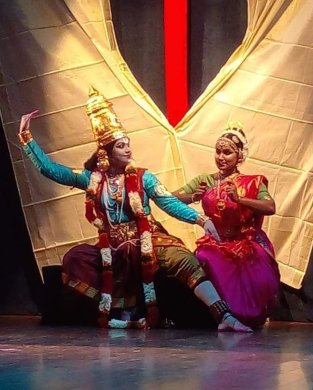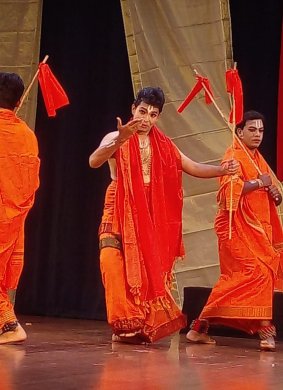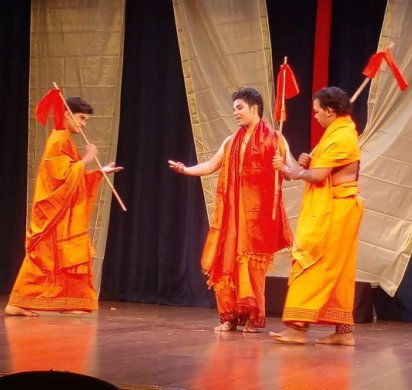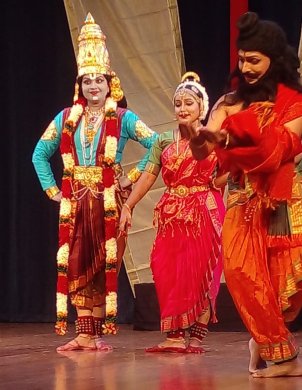
|   |

|   |
Tirumangai Azhvar Divya Katha: A sincere attempt - B. Naveena e-mail: naveena_b_2002@yahoo.co.in Photos: Ramki July 8, 2023 The lives of great savants and devotees often have similarities - they go astray, undergo tribulations because of this, eventually learn a lesson and are helped by the hand of God to finally rise above the mundane. At the core of all this is their unwavering devotion. Valmiki was a highway robber, while Bhadrachala Ramadasu used up public funds to build a temple for Rama. Parakala (Tirumangai Azhvar's earlier name) waylaid travellers to obtain money to perform Nitya Annadanam. This tale was given a visual dimension in Kuchipudi. Aficionados of Kuchipudi would well remember the magnificently crafted and tastefully choreographed productions of Dr. Vempati Chinna Sathyam, which remain the benchmark in this genre. Writer Gadepalli Venkat of Rajahmundry must be lauded for researching into and trying to imbibe the Tamil Vaishnava ethos into this Telugu production. Choreography was by Girish Chandra and Devi Girish, a dancer couple from Hyderabad. The production was performed at Chennai's R.R. Sabha on June 16, 2023. 

The dance-drama opens with a prayer to Vishvaksena and then proceeds to a rather lengthy description of the Azhvars, detailing their janma nakshatram (birth star), the respective weapon of Vishnu they are deemed to represent, etc. The scene then shifts to the entry of the valorous warrior Parakala (Girish Chandra), which was fittingly done with pizzazz. He is made a vassal of the Chola kingdom and is given the province of Tirumangai to rule over. He falls for the lovely Kumudavalli (Devi Girish), who stipulates that, in order to marry her, he must embrace Vaishnavism and start doing annadanam (free food) on a daily basis. All is well for some time, until his wealth dries up. To satisfy the latter condition he finally resorts to waylay travellers. One day, he is unable to usurp money from a traveller, who (predictably) turns out to be the God Himself. Parakala is arrested by the royal authorities for failing to remit the royal cess and is imprisoned. Around the same time, heaps of sand piled up on the river Vaigai turn into piles of gold. Parakala is freed by the king, though the script leaves the audience to infer that this is due to Parakala's devotion. One wishes there was an explicit statement to this effect, to enhance the devotional appeal. Parakala becomes a sanyasi, renovates the ruined temple of Parimala Ranganatha in Tiruindalur and pens several masterpieces, including the Periya Tirumozhi. The script was seamless and had many high points, such as a beautiful duet between Parakala and Kumudavalli, underscoring the greatness of music and dance respectively. Parakala comparing the beauty of Kumudavalli with the natural specialties of Tamilnadu was another nice addition. The mention of various dishes while annadanam was carried out, added the right dose of humour. Indicating the salient features of Vaishnavism, during Parakala's induction ceremony, was another beautiful and pithy composition. 

Girish was apt as Parakala, while Devi was a natural and good choice for his spouse. The dancers who appeared in the introduction and in the interludes need to hone their skills, especially at coordination. Excepting Girish, none mimed the lyrics, though vachika abhinaya is one of the distinct features of Kuchipudi. The modern hairstyle that Parakala sported for almost 90% of the performance time could have been replaced by a more royal and dignified hairdo. The newlywed couple dancing on the brass plate seemed a refreshing addition, but Girish surely needs to add grace into his dancing, bending at the waist during sideways movements. Music composed by D.S.V. Sastry was melodious at most places, though a tad too theatrical at a juncture or two. His rendition of Kamboji and Maand deserve special mention. The rather long-winding introduction to Azhvars ate into the length of the main story, stretching the performance time to more than 2.5 hours. It didn't help that there was a 50 minute delay in starting the program either. One can appreciate the intent behind packing information into the script, but staying strictly within the popular 1.5/2 hour time frames is advisable to sustain the interest of the audience. Wrong pronunciation in the Samskrtam verse "Aartaah vishannaah" from the Vishnu Sahasranamam, and grammatical flaws in the verse written to extol the Ashtakshari mantra of Narayana, demand attention. The namam backdrop achieved by long pieces of silken cloth was aesthetic.  B. Naveena holds an MBA in HR and MA in Samskrtam. She is invited by several prestigious institutions to write and speak on the fine arts and language. She is also a translator, singer, and quizzer. |